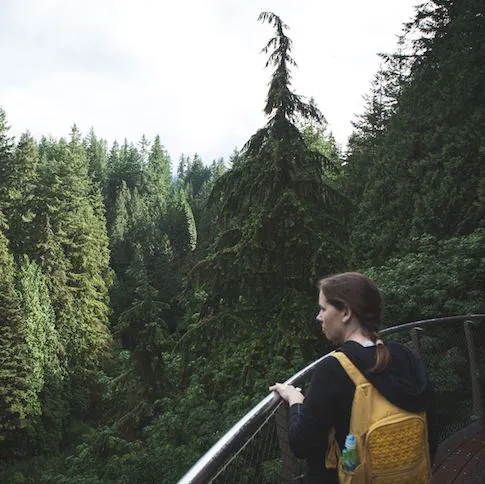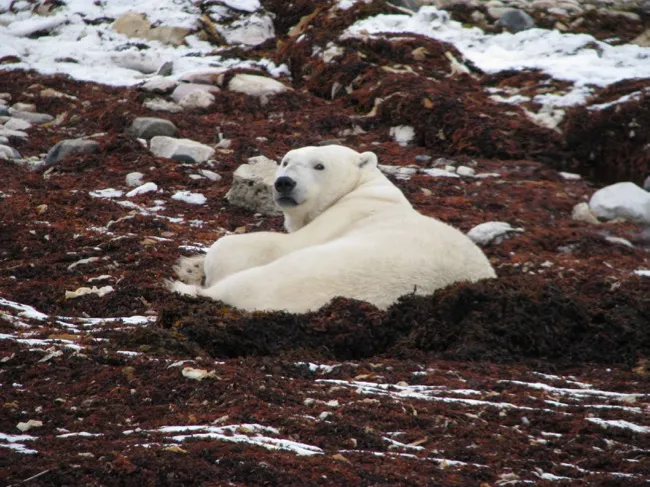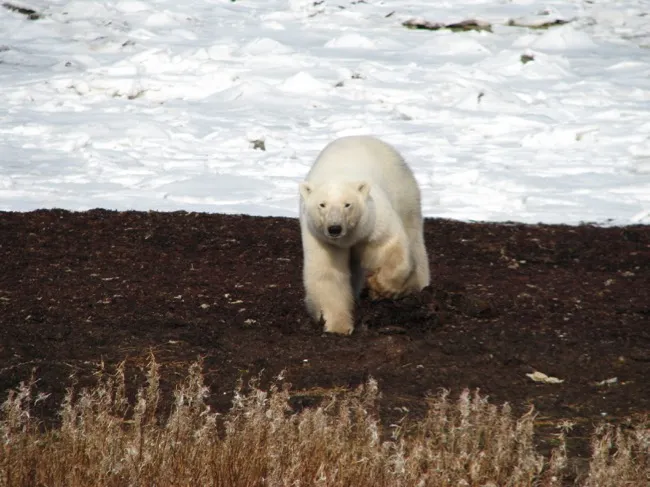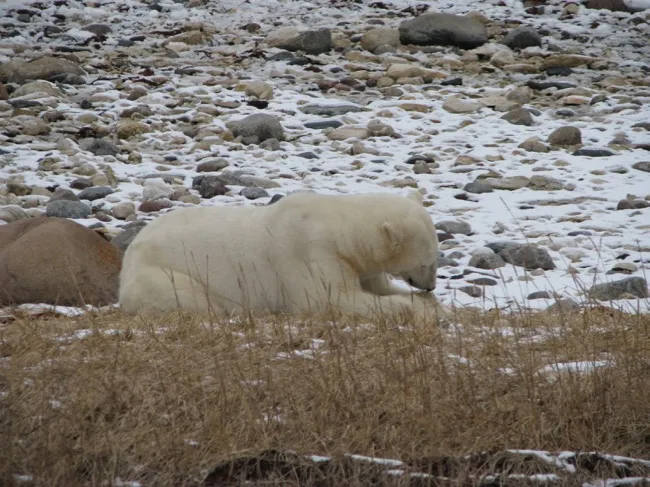Lunch with a polar bear



A year ago I was getting ready to leave for Churchill, Manitoba – because it was polar bear season and I wanted to see polar bears. Just over five months ago I gave a presentation about my polar bear adventures to a small group of Popular Culture Association of Canada conference participants. Now it’s just about polar bear season again, so it’s time to write about my Churchill trip here.
If you read on, you will find some slightly modified excerpts from my presentation. If you care to read the entire paper as delivered at the conference, complete with academic references, you will find a link to the document in PDF form at the bottom of this post.
If you want to learn more about the kind of polar bear adventure I experienced, head to the Churchill Northern Studies Centre website and read the description of the Lords of the Arctic learning vacation. Even better, sign up yourself. I absolutely recommend it.
Reflections on Entangled Interspecies Relations
“The privilege of people accompanying animals depends on getting these asymmetrical relationships right.” — Donna Haraway in When Species Meet (2008)
 Churchill Wildlife Management Centre, October 2016
Churchill Wildlife Management Centre, October 2016
1. Polar bears can look deceptively cute but they are dangerous animals.
A visitor arriving in Churchill, Manitoba, is likely to learn this fact quickly and to be reminded often. There is a difference between knowing a polar bear is dangerous and understanding that danger and what it means.
As “Polar Bear Capital of the World” Churchill relies heavily on the economic value of wildlife tourism – in which the polar bears feature as a starring act. A heightened awareness of human–polar bear relations is necessary for keeping not just research facilities, but also businesses, employees and guests alive.
2. How to safely see bears.
The primary and predominant means of seeing polar bears is to go on a “Tundra Buggy” or “Polar Rover” outing into the Churchill Wildlife Management Area. If you haven’t seen a Buggy or Rover, try to picture something like a monster truck version of a school bus.
Our guides assured us that the presence of tour buggies doesn’t seem to bother the bears. In fact, they tended to grant the polar bears a degree of agency in these encounters, suggesting that if the bears wanted to avoid us there was plenty of available land they could explore out of sight of the buggy trails.
Still, drivers made an effort not to startle or disturb the bears we spotted, moving the vehicle slowly while encouraging us to be quiet as well. The bears seemed aware of us, some more than others, but for the most part they ignored us, making the few moments of active interest all the more striking.
 Churchill Wildlife Management Centre
Churchill Wildlife Management Centre
3. Constructing the bear encounter.
My Churchill learning vacation was a full week long, but we took just two Rover trips into the Wildlife Management Area. Bear outings are expensive, and surprisingly tiring. There’s also the risk that repeated outings could transform novelty into routine. With so few available trails and the hungry bears conserving their energy, seeing more could mean seeing more of the same.
The constructedness of our bear encounters was a significant part of the “learning” side of my “Lords of the Arctic” vacation. The Rover drivers spent time talking about the tourism enterprise they were involved in, about the vehicles and the regulation of their use in the Wildlife Management area.
The drivers’ commentary demonstrated a fair degree of insight into the tensions between conservation and economics, protection and education, the integrity of the local ecosystems and the financial needs of the town. It seemed to me as though the drivers were approaching their time with us as a form of education, and they used the constraints shaping our outings as a launch pad of sorts for “teaching moments,” encouraging us to join them in a more reflexive understanding of what we were doing and how our wildlife tourism fits into a set of local and broader issues.
Furthermore, the extra days before our bear outings gave us time to learn more about the polar bears’ place in a larger picture – we learned about different and varying bear populations, about other animals they eat and/or share the north with, about threats to polar bears’ survival, their political significance, and the meanings they hold for some indigenous peoples.
 Itsanitaq Museum – Churchill, Manitoba
Itsanitaq Museum – Churchill, Manitoba
4. The importance of seeing.
While out on the tundra, we consumed the sight of these polar bears. The bears appeared to us as objects of aesthetic appreciation and wonder, and the seeing functioned (and functions still) as currency in the ongoing negotiation of one’s symbolic status.
And we compiled visual records of our experiences. For my vacation group, the photography most likely to be mimicked, in aspiration if not in execution, was the “NatGeo” (National Geographic) image or video. “NatGeo” represented the ideal we measured our images against. If we, as polar bear tourists, were after a “trophy,” this was it.
We also compiled these visual records to share with friends and family, to allow us to relive at least some part of our wonder later, and to weave these moments into our individual stories. And we bonded over this common effort.
5. Lunch with a polar bear: something more.
While I sat inside the Rover, eating my sandwich, apple and cookie, the bear I was gazing at through the window lay on the tundra outside, snacking on the long grass around it. I lunched, the bear snacked. I felt the cold breeze on my face as I had left the window open; I could see the breeze ruffle the bear’s fur. And I felt like we were dining together, in the only way that we could.
 Churchill Wildlife Management Centre
Churchill Wildlife Management Centre
6. Provisional conclusion.
Sitting in a Polar Rover in the Churchill Wildlife Management Area, I gazed at one specific wild polar bear enjoying a snack. But I also gazed on a bear whose physical condition was somehow a marker of the health of the global polar bear population.
As I sat and watched, my gaze also contributed to a feeling of possessiveness, as if this bear before me was my polar bear, in contrast to the many bears in photos and videos I had seen before my trip and since.
I also reflected on the fact that this was not my bear, that this bear was, that all polar bears are, beyond my ownership, my reach and even, to a great extent, my understanding. These are only a few of the ideas and feelings circulating through and around my mind while I sat and had lunch with a polar bear.
Entangled interspecies relations.
I feel it’s important to remember that my experience with these polar bears was not a unidirectional encounter. The bears were often still, yes –conserving energy while they waited for the Bay ice to form. And, yes, they rarely paid us much attention. But now and then, they did look back, or approach. And even the choice to not walk away from us was a kind of response to our human and technological presence.
These bears around us were not passive objects, placed and waiting to be visually consumed. Inside the tundra buggy we were, in a literal sense, the ones inside a box for the bears to view or not. These polar bears encountered us as we encountered them, as active agents, even if their agency and ours remain entangled in uneven, asymmetrical relations.
Lunch with a polar bear: PCAC 2017 conference presentation manuscript
My thanks go out to the folks at the Churchill Northern Studies Centre – especially the excellent kitchen staff who made me feel like I was in vegan heaven. Thanks also to the folks from the Leatherdale International Polar Bear Conservation Centre who led our learning vacation. And to my fellow travellers and polar bear enthusiasts, who helped make this experience as magical as it became.
All photos taken by me, Laura Wiebe.